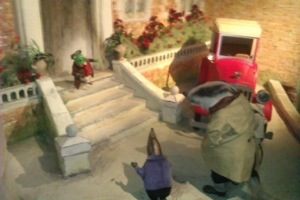
Start – Denmead, End – Emsworth, Distance – 12 miles, Difficulty – moderate
So, the final leg of the Wayfarers Walk; we hadn’t returned to finish the walk for months but really wanted to finish it by the end of the year (2021), so on the last day of 2021, we set out again. An overcast, dull winter’s day but with no rain forecast, a good day to get back to the trail although we definitely missed the blue skies and y the end of the day, walking in the dark, we realised how we missed the long days of the spring and summer.

From Denmead the walk took us out of the village and across the golf course driving range before we were back in the countryside and crossing very muddy fields – the photos tell the story of what the weather had been at the end of 2021; the fact that more of this leg than any of the others was on tarmaced roads was probably a good thing, although far less interesting. At Purbrook Heath we travelled on the Roman Purbrook Heath Road – the road that originally joined Winchester to Chichester. There may have been a Roman settlement on Purbrook Heath. In the early 13th Century the name Purbrook is recorded as ‘Pukebrok’ or ‘Pokebroc’ probably coming from the Old English word ‘pucanbroc’ meaning ‘goblin’s brook’. On this damp, misty day it’s easy to think of this as a place of goblins!

The footpath led us north behind a row of houses where the ground was really churned up and pretty slippery but then we were back to a road and absolutely no views as the fog and mist hung low over everything. The views are supposed to be amazing looking out Langston Harbour, Portsmouth and even the Isle of Wight but on this day we saw nothing. The trail loops around Fort Purbrook, an imposing austere building that’s now an activity centre but was building originally began in the 1860s, to defend Portsmouth against attacks from the French. It is one of a number of forts built at this time, known as Palmerston’s Follies as they were never used. Lord Palmerston was the Prime Minister whose government signed off the building of several hill forts at enormous cost; in actual fact France had no warlike intentions towards Britain. A neurosis of the French seems to be a common theme of British governments. During WWI the fort was armed with anti-aircraft guns and used as a siege artillery barracks and then in WWII it became a barracks, ambulance base and centre for civil defence housing the 65th Chemical Warfare Company in 1940 (they were responsible for preparations for possible nuclear attack). The weather is damp and grey offering only murky views across to the sea. The fort itself looks depressingly unkempt and I discover that it is in fact on English Heritage’s At Risk Register as being in ‘poor condition’. It makes a decent spot for lunch for us.

Refuelled, we continue by following the road into Bedhampton and crossing the A3(M) and then A27; it’s all very different to the earlier walks and it certainly doesn’t feel like an area where shepherds would be walking with their flocks. Fortunately it becomes more interesting again as we walk alongside a tidal creek that opens up to Langstone Harbour. Following the sea wall around the coast the path then took us to the pretty village of Langstone and around the front of The Ship Inn, originally an 18th Century wharfside warehouse handling grain, now with a handful of people sitting outside watching the tide and lights from small boats in the marina nearby. Langstone Harbour is full of mudflats making it a Site of Special Scientific Interest with two thirds of it being an RSPB Nature Reserve it’s supposed to be fabulous for spotting wading birds. Unfortunately we were, by now, walking in the gloam although we were lucky to spot dozens of little egrets roosting in the trees alongside Langstone Mill Pond, the millpond that once powered Langstone Mill. The silhouette of the old mill was striking in the dark – it was a working mill until WWI – sitting across a creek, the remaining black tower of the windmill, its sails long gone, a distinctive feature of the landscape.

The path continued past the remains of Warblington Castle which we missed completely as not only was it completely dark but also increasingly muddy. The only part of the castle that has survived is part of the gatehouse, of a once splendid fortified house. Warblington is believed to be named after the Saxon invader Weorbald who found Langstone harbour in about 500AD. Margaret Pole, Countess of Salisbury (daughter of George of Clarence – brother of King Edward IV and King Richard III) built the fortified house between 1515 and 1525. However, as part of a Catholic family, she lost favour under Henry VIII and was arrested for treason with the rest of her family in 1538 and their land and titles were lost. She was executed two years later apparently by an inexperienced executioner who took 10 blows to kill her, hacking her head and shoulders to pieces, in his attempts. Her headless ghost is supposed to haunt the remains of the castle and the churchyard of St Thomas à Becket’s Church. Walking through the ancient churchyard in the dark on the last day of the year was spooky especially with the added knowledge that it had a couple of huts for grave-watchers; built in 1829 when body snatching was rife when doctors and medical schools wanted corpses for dissection and were willing to pay for bodies that thieves stole from graves. Fortunately in 1832 the Anatomy Act ended the act of body snatching. Perfect fodder for spooky storytelling!

Once out of the churchyard we tramped through more muddy fields and a woodland before finally arriving at Emsworth’s foreshore. All in the dark! I know that in daylight it’s a lovely town and the views across the tidal Mill Pond quite picturesque. And of course, because it was New Year’s Eve, there were no pubs open for us to celebrate the finishing of the Wayfarers Walk – and the finishing of the final leg definitely deserved to be celebrated! Our second long distance walk finished.





